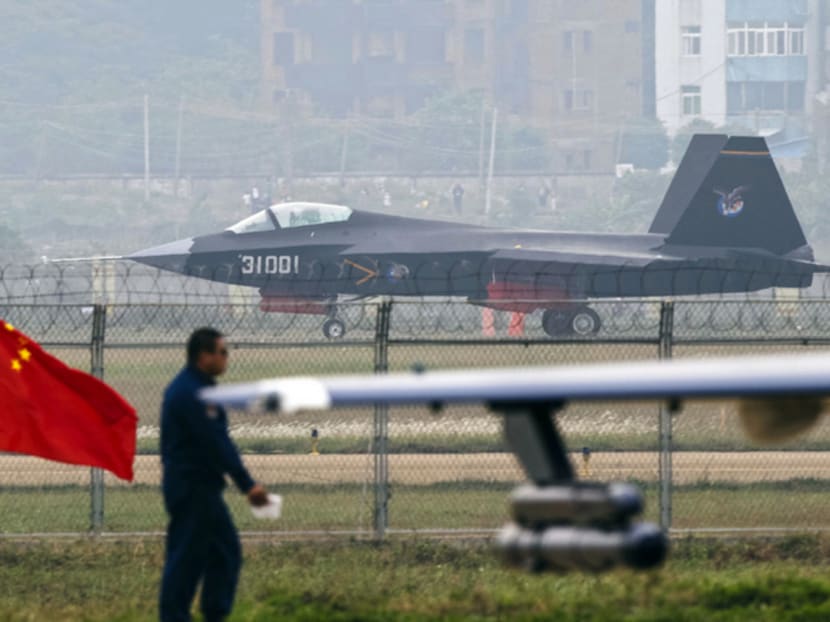China’s military closing tech gap with America
SINGAPORE — China’s military is closing the technology gap with the United States, although the experience of America’s pilots still gives them an “unbelievably huge” edge, said the chief of the US Pacific Air Forces.

A J-31 stealth fighter (background) of the Chinese People’s Liberation Army air force. Photo: Reuters
SINGAPORE — China’s military is closing the technology gap with the United States, although the experience of America’s pilots still gives them an “unbelievably huge” edge, said the chief of the US Pacific Air Forces.
General Lori Robinson, in Singapore to attend the country’s air show, said she felt assured Chinese pilots would act professionally in interactions with the US, citing a September agreement on rules of behaviour. US military pilots flying in the contested South China Sea have been warned over radio — sometimes repeatedly — by Chinese voices telling them to leave, while Japanese planes have been challenged in the neighbouring East China Sea.
Since coming to power, Chinese President Xi Jinping has prioritised modernising the military with a focus on the navy and air force, as he seeks to project power outwards and assert China’s claims to territory in the waters of the West Pacific. That has included greater spending on longer-range and higher-tech ships, planes and submarines, while the People’s Liberation Army has also focused on improving fighter pilot training and standards.
“The technology gap certainly is closing, there’s no denying that,” General Robinson said yesterday in an interview.
“The difference between that technology gap is the training the US air crew get. That training and the way our airmen work every single day, no matter what platform they are on, and all the people that support those airmen, to do that job. That edge is unbelievably huge.”
The Pentagon, in a report released last May, said China’s rapid military modernisation “has the potential to reduce core US military technological advantages”. China is “investing in capabilities designed to defeat adversary power projection and counter third-party — including US — intervention during a crisis or conflict”, said the report. Security analysts, however, have expressed doubts about the ability of China’s military pilots, noting a substantial portion of training time was spent learning doctrine. That has raised concerns about them acting rashly in proximity to planes from other nations.
Shortly after General Robinson took her post in October 2014, she said the US was concerned Chinese jets may engage in further risky intercepts. A Chinese fighter flew within 6m of a US P-8 Poseidon aircraft flying at more than 640kmh near Hainan Island — China’s gateway to the South China Sea — in August that year, an encounter the Pentagon called “unsafe and unprofessional”.
The core of US-China air tensions is what activities are permitted within a country’s 200 nautical mile offshore exclusive economic zone, where coastal states have sovereign rights over marine resources. The US says international law permits such flights, which have been standard practice for decades. China claims such freedom is reserved for civilian aircraft.
China contests more than 80 per cent of the South China Sea, putting it at odds with fellow claimants including Vietnam and the Philippines in a body of water that annually hosts US$5 trillion (S$7 trillion) in shipborne trade. In the past two years, China has reclaimed more than 1,200ha in the sea and is building military facilities there. It has made greater use of fishing and maritime surveillance boats to warn off other vessels in the area, blurring the lines between its navy and coast guard.
General Robinson said the US would continue to fly in international airspace when required. “Any airplane that we need to go from point A to point B in international airspace will do that,” she said. “It’s not unusual for us to fly throughout the region and international airspace.” When asked if the Chinese were still warning US military planes away from the South China Sea, she said “They are talking, but mostly in my world from airplanes to airplanes, everybody has acted professionally in accordance with the rules of behaviour”.
She said any discussion of the US having to cede ground to China in Asia as that country’s economic and military clout grows was hypothetical.
“What I depend upon today is our presence in the region, because our presence in the region provides that stability and capability in the region,” she said. “Our presence in the region allows for us to have partnerships throughout the region.” BLOOMBERG






